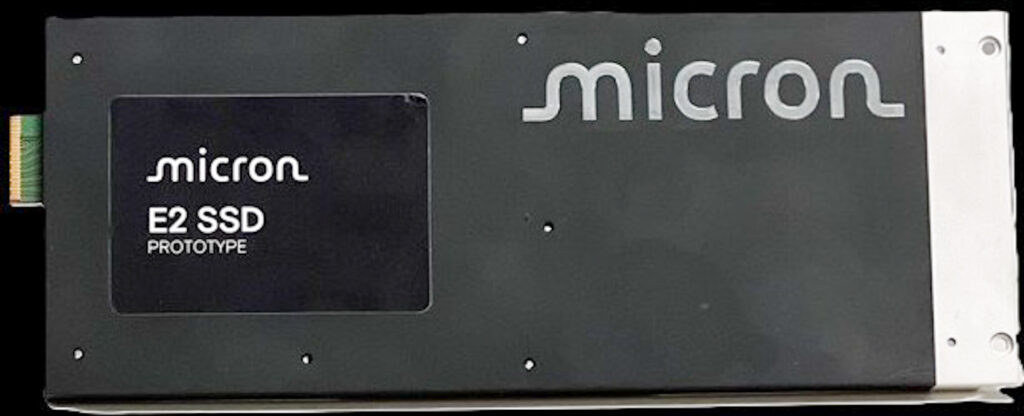Once reserved primarily for archival use, large-scale data lakes are now asked to support increasingly active workloads. New AI applications, analytics pipelines, and emerging digital services are driving up the “temperature” of previously considered cold data. The result is a growing middle ground, where data is accessed too frequently for HDDs to handle efficiently, but not hot enough to warrant the cost of performance SSDs. E2 is a new flash form factor to address this emerging “warm” storage tier. It is designed to bridge the gap between high-capacity hard drives and traditional enterprise SSDs, offering a more practical balance of performance, density, and cost.

The Storage Networking Industry Association (SNIA) and the Open Compute Project (OCP), two communities comprising some of the largest users, manufacturers, and standard maintainers of data center equipment, including (but not limited to) Meta, Microsoft, Micron, Pure Storage, Samsung, and Sandisk, have already designed and begun prototyping the new SSD form factor. Made from the ground up for high-capacity deployments in 2U servers, these new drives will feature up to one petabyte of QLC storage per device. They will reuse the industry standard EDSFF connector, as previously seen on E1 and E3 devices.

Physical Dimensions and Specifications
In an upright configuration, the physical size of each drive will be 200 millimeters (~7.9 inches) in length, and 76mm tall (~3 inches), with a thickness of only 9.5mm (~0.4 inches).

The E2 height and connector alignment specifications are derived from the E3 standard, while the indicator LED placement follows the E1 SSDs.
This size is ideal for dense storage servers, accommodating up to 40 E2 SSDs in a 2U node, which can translate to up to 40 PB in a single server. Drives communicate using the NVMe protocol over a generation 6 or higher PCIe 4-lane connection, and can use up to 80 watts of power per-SSD (although most drives are expected to run in the 20-30 watt range). This means a fully populated server could theoretically draw anywhere between 0.8 and 3.2 kilowatts just for storage! The thermal load resulting from a high-power configuration could present a significant challenge for traditional air-cooled designs, but such designs are unlikely.
From a performance perspective, E2 is targeting 8-10 MB/s per terabyte. Performance will be substantially higher than that of HDDs, reaching up to 10,000 MB/s for a one-petabyte drive. However, capacity is the ultimate goal of the E2 standard, as demonstrated by its massive 64 NAND package site support. For the intended use cases, the performance of E2 needs to be “good enough,” or said another way, for this class of storage, there’s no reason to pay more per TB than is absolutely required.
E2 SSD Specifications
| Length | 200mm (~7.9 in) |
| Height | 76mm (~3 in) |
| Width | 9.5mm (~0.4 in) |
| Connector | EDSFF (SFF-TA1002 connector and SFF-TA-1009 electrical pinout)
27.7mm alignment (from bottom of drive) |
| NAND Packages | 64+ |
| Protocol | NVMe |
| Bandwidth | PCIe 6.0 (or higher) 4x (256 GT/s) |
| Power Per Drive | ~80W |
| Capacity | Up to 1 PB |
| Official Specification Name | SFF-TA-1042 – Enterprise and Datacenter 2U Form Factor (E2) |
| Revision 1.0 Expected Time | Summer 2025 |
Manufacturer Motivations
Micron is a significant contributor to the E2 standard development and is likely to utilize it as a new tool in its battle against hard drives. With this new form factor, Open Compute Project engineers and designers aim to bridge the gap between the “fast but costly” SSDs and the “slow but affordable” HDD storage tiers, thereby reducing the total cost of ownership due to factors such as power, cooling, and longevity. A competitive middle-of-the-road solid-state option for high-capacity storage systems would also help boost sales of NAND packages and lower-tier controllers.
Pure Storage revealed a 300-terabyte E2 prototype on May 14 during the OCP Storage Tech Talk event. It features a large flash controller, six-piece DRAM caches, and numerous capacitors for safe buffer flushing in the event of unexpected power loss. Adopting the E2 standard would enable Pure to offer customers cost-effective “tier two” storage options, a solution desperately needed by organizations and businesses seeking to reduce costs while still reaping the benefits of SSDs.
Looking Ahead: Will the Industry Be Ready for E2?
The E2 form factor represents a practical, flash-based answer to the growing need for high-capacity “warm” storage. It won’t replace HDDs overnight, but the combination of petabyte-class capacity, sufficient performance, and dense 2U deployment makes it one of the more compelling recent developments in enterprise storage.
That said, server platforms aren’t yet ready to support E2. Thermal, power, and physical integration challenges will take time to resolve, and we expect to see vendors debut new chassis designs optimized not just for the E2 form factor but also for the modern flash-based warm data lake use case.
Still, with prototypes already emerging and backing from major players like Micron and Pure Storage, E2 is on the horizon. We’ll be watching closely as the spec finalizes and hardware vendors begin the real-world work of turning this ambitious standard into something deployable.




 Amazon
Amazon